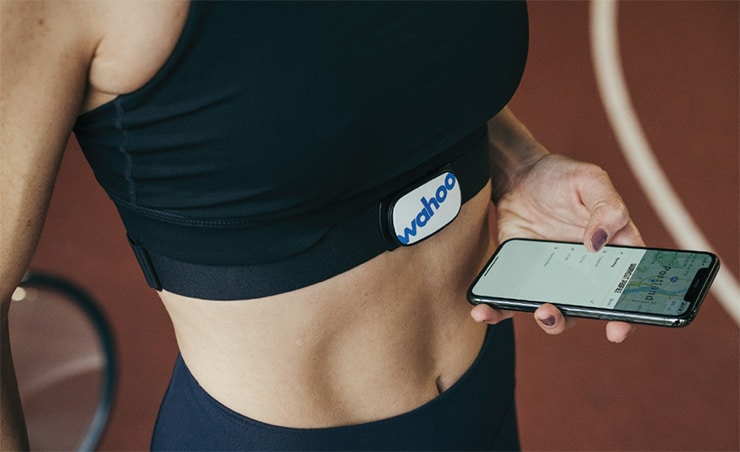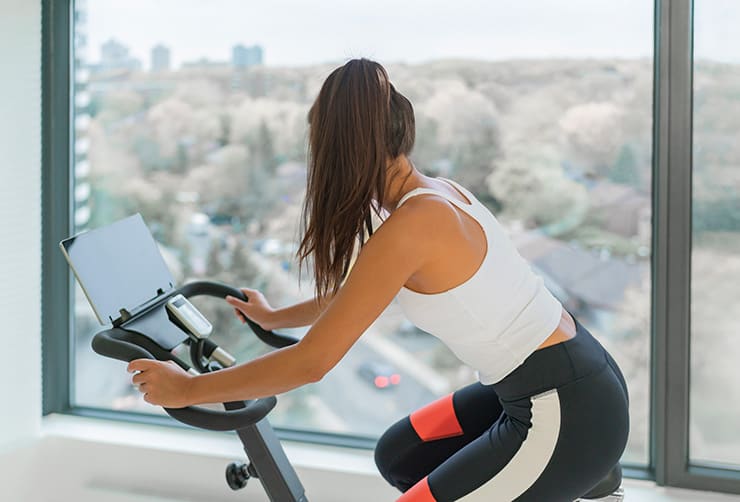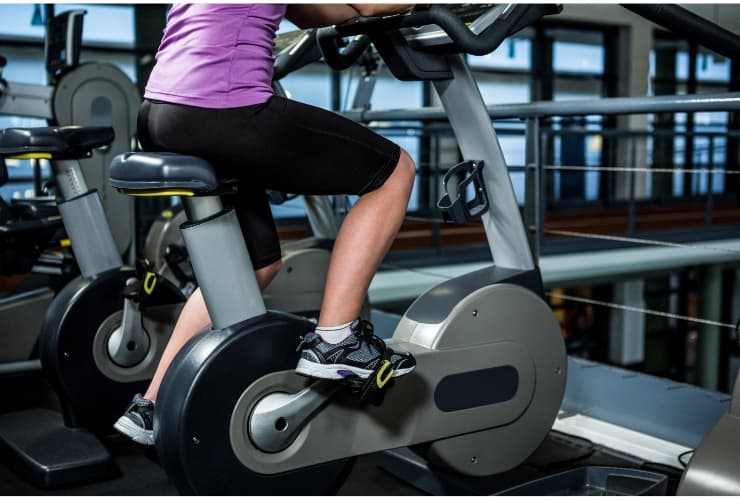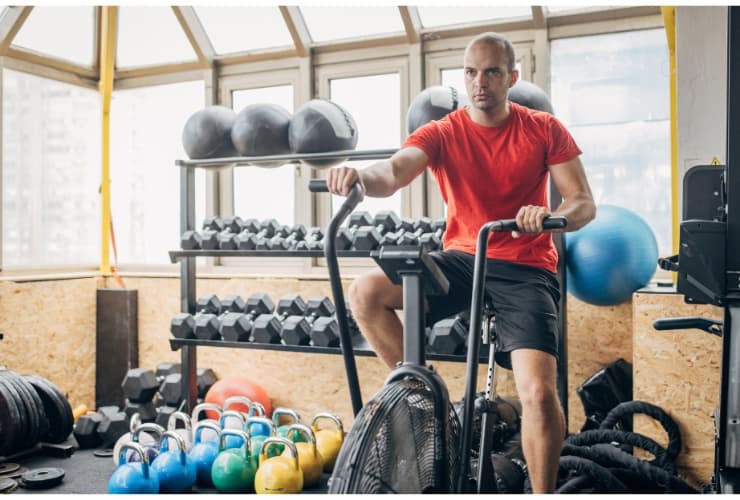Buying a stationary bike is only the first and (probably the easiest) step to becoming fitter and healthier. Using the bike consistently to attain your fitness goals is the more challenging part. You want to make sure you’re getting the most out of your investment and not just passing time.
People use different factors to measure their cycling workout progress, but one of the main ones is speed.
So, what is a good speed on a stationary bike? Is your speed average, below average, or above average? What can you do to improve? And more importantly, is speed even the best way to measure your indoor cycling session?
First, there isn’t a straightforward answer to what is or isn’t a ‘good’ speed. It depends on a specific person and what their goals are. Second, speed should not be the only factor you use to measure your biking workout progress.
I will discuss this in depth here and answer all the common questions. This is to help you best track your progress and get closer to your goals.
Key Takeaways
- A good speed on a stationary bike depends on your fitness level, weight, and goals.
- There is no universal answer to what is a good speed. But for most people, a speed of 13 mph would be considered moderate.
- Speed should not be the only factor you use to measure your indoor cycling session. You should also consider resistance, time, and heart rate.
- Pedaling faster helps you improve your endurance, while pedaling harder helps you build strength in your muscles. You should balance both for a well-rounded workout.
- Your speed on a stationary bike may not reflect your real riding speed outside. Use a power meter or an app to track your speed and distance more accurately.
Measuring Speed on Your Indoor Bike
When cycling on your indoor bike you’re, in reality, traveling 0 miles because you don’t move an inch. So, technically, your speed will be 0 mph.
However, it’s still possible to measure the virtual distance you have traveled and get a speed estimate. Some stationary bikes have inbuilt sensors and displays so you can see all your numbers, including speed.
If you have a basic exercise bike without the bells and whistles, you can use a power meter to help you track your cycling workout data.
Factors That Determine What a Good Speed Is for You

What’s a good speed for one cyclist may be below average for another; it depends on your goals and fitness level (among other factors).
For instance, a moderate speed of 13 mph would be good for a cycling newbie or someone who hasn’t been physically active before. If you fall into this category, a speed that you can maintain comfortably over the duration of your session is good.
From there you can begin to improve and go faster as you listen to your body and perfect your cycling form.
Suppose your goal is to lose weight. Cycling at a speed that helps you burn the most number of calories safely is good for you. A casual speed of 15 mph may be good for you, depending on your weight–the heavier you are, the more calories you’ll burn. But this same speed may not be good enough for an athlete training for a race.
So the bottom line is that a good speed depends on how fit you are, your weight, and what you’re looking to achieve.
What Speed is Considered Moderate on a Stationary Bike?
Generally, a cycling speed of around 13 mph is considered moderate. But again, this may vary from cyclist to cyclist.
Whether or not a certain speed is moderate or intense depends on your age and fitness level. If you can maintain a certain speed on your indoor bike with your heart rate in the aerobic zone then it’s moderate for you.
This means that you’ll not be out of breath even though your breathing will be faster. You can still hold a conversation.
What’s a moderate workout for you may be an intense workout for someone else.
There are five different heart rate zones and you need to understand yours to know what would be a moderate cycling speed for you.

Is 20 Mph on a Stationary Bike Fast?
It depends on the level of resistance that you have set and the duration of the session. With low resistance, I’d say 20 mph is not that fast for the average adult.
But if you set a high resistance and manage to maintain 20 mph for over 30 minutes then that’s impressive.
However, you need to understand that your indoor cycling speed may not be an accurate reflection of your performance if you go outside. When you take your road bike outside you’ll have to deal with wind, traffic, rough terrain, and more.
Is It Better to Pedal Faster or Harder?
Earlier, I mentioned that speed should not be the only thing you focus on to measure your workout progress. Pedaling faster has its benefits but a good workout should always be balanced. Therefore, there are two factors that you should be looking at: speed and resistance.
But which one is more important: pedaling faster or pedaling harder? Well, the answer depends on what you’re trying to achieve.
Let’s dive into this very popular debate.
Speed vs Resistance on a Stationary Bike
When you reduce the resistance on your stationary bike, you reduce the work that your leg muscles are doing. You’ll be able to challenge yourself to go as fast as you can for as long as you can. In turn, you build your endurance.
When you increase the resistance, making a pedal stroke becomes harder. You need to increase your power output to push against the resistance. High resistance helps you build strength in your muscles.
Note: be sure to set the resistance to a level that you can handle. You risk injury if the resistance is too much and you strain to maintain it.
So, which is better? If you want to improve your endurance, you should reduce the resistance and pedal at a higher speed. To build strength, you’ll need to go with more resistance and a lower speed.
For maximum benefit, you should balance speed and resistance.

What Is a Good Speed on a Stationary Bike for Weight Loss?
In addition to improving your cardiovascular health, your stationary bike can help you shed some pounds.
With indoor cycling, you can burn calories efficiently and create a calorie deficit, which is how you lose weight.
According to Harvard’s calorie chart, you can burn 294 calories with moderate indoor biking. This is an estimate for a 185-pound person. How many calories you burn depends on your weight and effort during a workout, among other factors. The heavier you are, the more calories you’ll burn.
You can also burn more calories by making your workouts more intense. A 185-pound cyclist can burn about 441 calories in an intense workout on their stationary bike.
Remember to learn your heart rate zones so you know what moderate or intense physical activity is for you. And even as you work towards burning calories, it’s important to eat right and combine cycling with other workouts.
These habits will help you lose more weight and live a healthier life.
Should You Use Speed to Measure Your Progress on a Stationary Bike?
First, your speed on a stationary bike is not an accurate reflection of your real riding speed. It’s simply an approximation based on your effort because you’re actually not covering any distance.
That said, you can still use speed to see if you’re improving. You just need to do it right. First, using the same bike helps because of consistency. If you don’t have a fancy stationary bike with displays you can get a power meter to track your speed and distance.
See if you’re pedaling faster and farther or slower than in your previous sessions. This is a great way to see how you’re doing–whether you’re improving or not.
However, don’t just rely on speed and distance since, on stationary bikes, they are not “real” numbers. Use time and heart rate as well, ans they are more accurate and make more sense.
Using time and heart rate gives you a pretty good idea of what you’re doing. This will be an even better option if you don’t have a stationary bike at home and can only access one at the gym.
With a heart rate monitor and a watch, you won’t have to worry about not getting consistent numbers every time you have to use a different spin bike.
You can push yourself by increasing your exercise time, and with a heart rate monitor, you can measure the true intensity of your workouts.

How to Improve Your Riding Speed on an Exercise Bike
First, you need to know your fitness level and understand your heart rate zones. You can easily do this with most cycling apps like Zwift.
Speaking of apps, indoor cycling apps now come with all sorts of features and many of them will help you improve your speed. For instance, a little competition can motivate you to pedal faster and farther. Even though you’re alone in your home, you can join virtual competitions on these apps.
Find a group ride that’s appropriate for your skill level and join in the fun. You’re less likely to get bored cycling with friends (even if they are virtual) and it’s an amazing way to build your endurance.
Another way to improve your speed on a stationary bike is to remain consistent. I know this is easier said than done. But if you only cycle once in a while you won’t make any progress.
Create a schedule and stick with it. Gradually increase your speed with every session and try to put in more effort.
Wrapping Up
What is a good speed on a stationary bike?
The answer depends on your fitness level and what you want to achieve. For instance, if you want to lose weight you can pedal at a moderate speed to burn around 250 calories in an hour or make your cycling more vigorous to burn almost double the number of calories.
If you just want to stay fit, you can pedal at a moderate speed for 150 minutes a week as recommended by the CDC.
Note that your moderate speed may not be someone else’s moderate speed. What is moderate depends on your age and fitness level, among other factors. Know your heart rate zones then aim to cycle at a speed you can maintain in your aerobic zone. That will be your moderate speed.
Lastly, don’t just rely on speed to monitor your progress. Balance speed and resistance to build strength in your muscles. Additionally, use time and heart rate to get an accurate idea of how much you’re doing.

